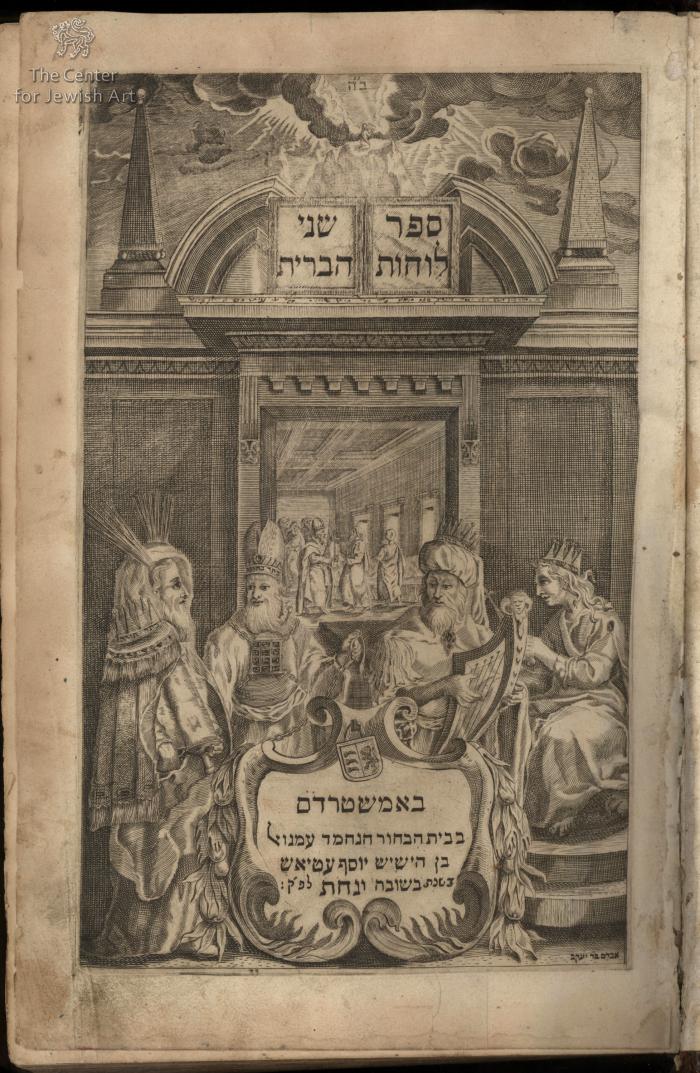Obj. ID: 35352 Shnei Luchot ha-Brit by Yeshaya ben Avraham Halevi Horowitz, Amsterdam, 1698

sub-set tree:
The following description was prepared by William Gross:
The renowned multipartite ethical and kabbalistic work by R. Isaiah b. Abraham ha-Levi Horowitz (“Ha-Shelah ha-Kadosh”). First printed in Amsterdam, in 1648-49, this edition of 1698 is considered one of the most beautifully produced Hebrew printed books. Chassidim consider the year of its publication as especially noteworthy, as it was the year the founder of Chasidism, the venerable Baal Shem Tov, was born. The book thus carries a special, almost amuletic, meaning today for its owners.
Title page with beautiful illustration of Moses, Aaron, King David and Kind Solomon. The copper engraving was done by the same artist who did the illustrations for the 1695 Amsterdam Haggadah as well as several other Hebrew books of the period.There is a signature on the title page. The book is bound in a deluxe, finely tooled leather binding over boards, with clasps.
R. Horowitz (c.1565 to 1630) was born in Prague to an illustrious rabbinic family. At an early age, he was recognized as a great Gaon, and took part in the meetings of the Rabbis of the Vaad Arba Ha Arotzos (Council of the Four Countries), together with the greatest Rabbis of his generation. He held rabbinical positions in various communities such as Dubno, Ostraha, Posen, Cracow, Vienna and Frankfurt, where he headed great Yehsivos and had large numbers of students. He eventually moved to Eretz Israel and became rabbi of the Ashkenazic community of Jerusalem.
His monumental Shenei Luchot ha-Brit, completed in Jerusalem, was begun as an ethical will, for his children only, while he was still in Prague. However, it grew continuously until it was a large work, becoming one of the masterpieces of Jewish literature. It consists of two parts: Derech Chayim [Path of Life], containing laws according to the order of the Festivals in the calendar, and Luchot ha-Brit, summarizing the 613 commandments in the order in which they appear in the Bible. Horowitz draws upon the vast Halachic, homiletical, and mystical literature of his predecessors and contemporaries to provide guidance for living an ethical life. It includes mystical notions, which by now had started to be the dominant form of ethical writing.
In his letters, Rabbi Yosef Yitzchak Schneerson of Lubavitch (Letter b 853), mentions the book Shnei Luchot HaBrit that was printed in 1698 (458 = nachat in numerical value) in an elegant edition. He notes that this is a sign from above that the revelation of this holy book caused "nachat" [satisfaction] above, and that same year the Ba’al Shem Tov was born. The Ba’al Shem Tov stated that he was born in the year that the Shla book was printed to illuminate the world with the light of the Almighty, with Torah and reverence and service of the heart.
This edition is from the press of Immanuel Athias, the son of the renowned Amsterdam printer Joseph Athias. A printer of both Jewish and non-Jewish books, the elder Athias printed many Bible translations in the late seventeenth century, including more than a million English Bibles for England and Scotland.
Immanuel Athias took over the Hebrew section of his father, Joseph's, press in 1685. Although the father is better known, especially for his Bible editions, it was Immanuel who was responsible for the family's high repute in the world of Hebrew books. His four-volume edition of Maimonides' Mishneh Torah (1702), of which 1,150 copies were printed, was described by M. Steinschneider as "one of the most elegant and beautiful Hebrew editions to have ever appeared." His last issue was a Sephardic rite prayer book (1709). Much of Athias' printing material, which was highly regarded, became the property of the Proops family in 1761.










